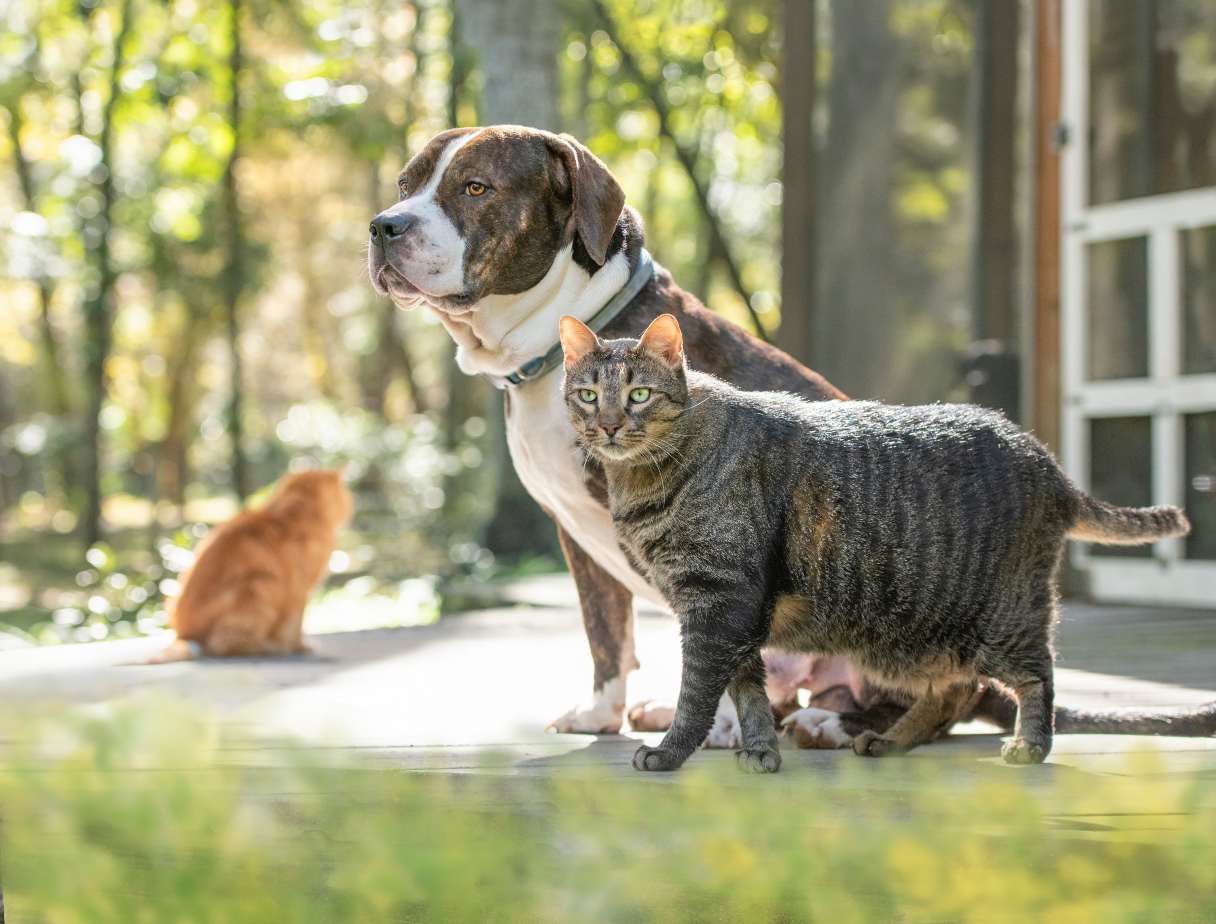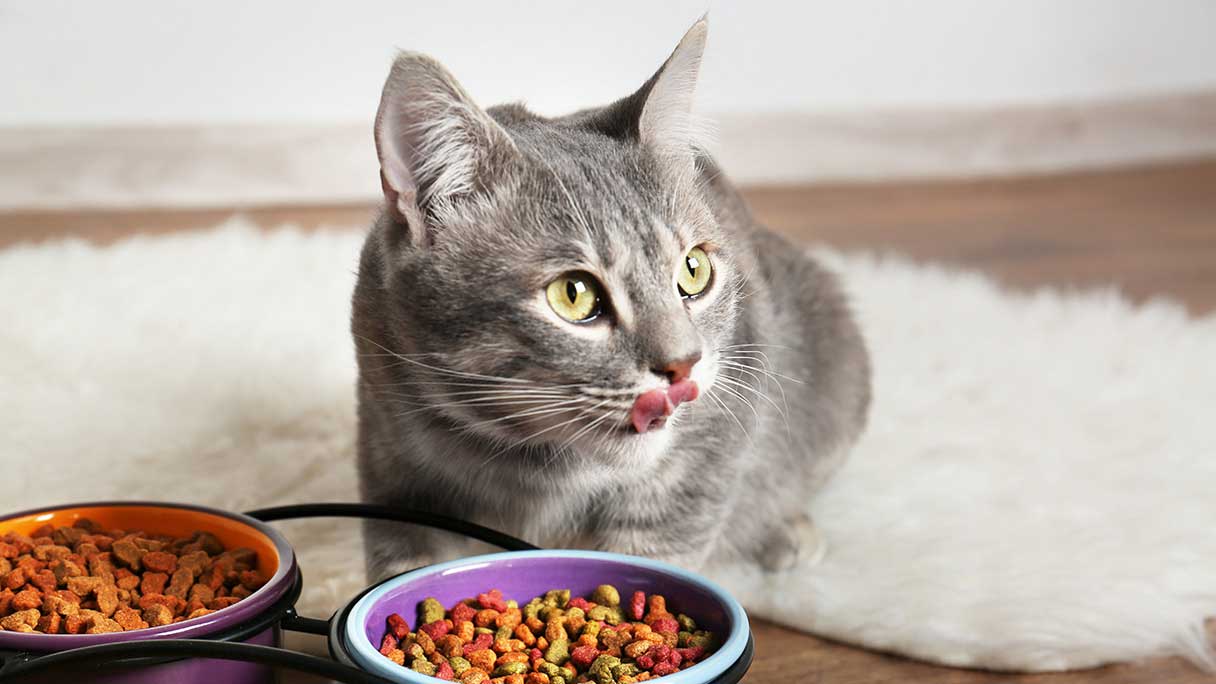That squishy belly on your kitty or pup might look adorable and feel fun to squeeze, but in reality, about 59% of dogs and 61% of cats in the United States are classified as overweight or obese.1
Sadly, cute as it may be, a big belly is not healthy for your pet. Pet obesity is associated with the following health conditions in both dogs and cats:2
- Arthritis
- Cancer
- Diabetes
- High blood pressure
- Heart disease
- Insulin resistance3
- Joint and bone problems
- Respiratory issues
Excess weight can also shorten your pet's life span, as well as reduce their overall quality of life.3 That's why it's important to monitor your pet's weight and take action to help them stay fit and healthy. Follow the tips below to help get your pet to a healthy weight — and to help keep them there.
1. Talk to Your Veterinarian
A lot of factors can contribute to pet obesity, including age, breed and genetics, nutrition and feeding, activity level and underlying health conditions.3 Your vet can provide an accurate assessment of your pet's weight, size and body condition, as well as check your dog or cat for any health issues that might be causing them to gain weight.4 They can also evaluate your pet's diet and help you put together a weight-loss plan, which may include prescription pet food formulated for weight loss.4
In addition, regular weigh-ins each time you visit the vet will help both you and your vet know whether your dog or cat gains too much weight. If they do need to lose weight, regular weight checks at the vet will help track their progress. A good weight-loss goal for pets is 1% to 2% of their total body weight each week.4
2. Measure Your Pet's Food
Free feeding — that is, leaving kibble in a bowl for your pet to munch on throughout the day — tends to contribute to overeating, as it provides an opportunity for pets to eat out of boredom and not just hunger. It also makes it difficult to track your pet's calorie intake.5
It's much easier to track and control your pet's calories by measuring their food, only giving them the daily amount for their size as recommended by either your vet or the pet food manufacturer.4
3. Feed Them High-Quality Pet Food
Not all pet foods are created equal. Many are loaded with fillers, including low-quality sources of carbohydrates that add empty calories without nutritional value. Look for food that has the stamp of approval from the Association of American Feed Control Officials (AAFCO), which will help ensure balanced nutrition.3
Also, read pet food labels and look for food with these characteristics to ensure you're choosing a high-quality pet food for your fur baby:7
- The right amount of protein for your pet's life stage. For adult maintenance, the general recommendation is at least 18% for dogs and 26% for cats.6
- Real meat or fish as the first ingredient.
- High-quality, nutritional sources of carbohydrates, including brown rice, potatoes or sweet potatoes or real fruits and vegetables.
- Avoid foods with corn or corn products, or excessive amounts of wheat as fillers.
- Also avoid foods with chemical additives and preservatives, as well as artificial dyes or added sugars.
4. Help Your Pet Move More
Keeping your pet from overeating is only half the battle. The other half involves making sure they burn more calories than they consume by providing exercise. Cats need at least 30 minutes of physical activity each day to stay fit and healthy,8 whereas dogs need anywhere from 30 minutes to two hours or more, depending on their breed.9
Lest you think you have to lace up your athletic shoes and spend two hours walking your large, energetic dog every day, walking is only one way to exercise your pup. Playing with them, taking them hiking or swimming, setting playdates with other dogs and letting them chase and wrestle with each other are all additional ways to ensure your dog gets plenty of physical activity.
As for cats, placing their food up high, hiding food around the house and providing cat trees that encourage them to jump, reach and climb will help keep them active.
5. Use Toys and Play to Get Them Moving
While walking your dog and using some of the strategies mentioned above to get your cat moving are important, it's also vital to make time regularly to play with your pet. Interactive play is not only a great way to bond with them, but it also contributes to their mental and emotional well-being.8 It makes exercise fun, too.
Choose interactive toys for your dog that they can tug, chase or fetch. For cats, feathers or toy mice attached to a pole by a string that you can dangle for them are sure to get them moving as they try to catch it. Playing hide-and-seek with a favorite toy or hiding pieces of kibble around the house is another fun way to engage your pet and incorporate more exercise into their day.
6. Watch the Treats
The general rule of thumb is that calories from treats should make up no more than 10% of your pet's daily diet. That means that for every treat you give your pet, you need to subtract an equal number of calories from their kibble or canned food allotment for the day.10
It also means that healthy treats, like vegetables and the occasional piece of fruit, will go a lot farther than calorie-dense dog treats and chews. So, consider letting your pup munch on a carrot stick or a piece of broccoli instead of a hot dog, a hunk of cheese or a commercial dog biscuit or bully stick. Another option is to simply set aside 10% of their food to dole out to them as treats and rewards throughout the day, which works as well for cats as it does for dogs.10
7. Schedule Their Meals
In addition to measuring your pet's food, feeding them on a consistent schedule will help control their calorie intake. Not only that, but it will make it easier for you to notice changes in your fur bud's appetite that could indicate a health problem. Consistent meal times will also satisfy your pet's craving for routine, which will actually help them feel more secure in the long run.11
Vets generally recommend feeding adult dogs twice a day, splitting their daily food allotment over two meals.12 Puppies and pregnant or nursing dogs, as well as dogs with certain health conditions like diabetes and some giant breed dogs, need to eat more often, so talk to your vet about what's best.12 Healthy adult cats also generally do best with at least two regularly scheduled meals per day.13
8. Don't Feed Them Table Scraps
It's never a good idea to feed dogs or cats food that has been prepared for human consumption. For one thing, humans eat a lot of foods that are toxic to pets, which includes seasoning and spices. For another, food on your dinner plate often includes butter, oils or other fats that not only ratchet up the calories but can have serious adverse effects on your pet's health.
And while you might think a little nibble here and there won't hurt your pet, you'd be surprised at how fast those extra calories can add up and contribute to excess weight — especially if your entire family is giving them “just one bite." That's why it's important to talk to your family and help everyone understand that, for the sake of your pet's health, feeding them table scraps is a habit that must stop.3
9. Help Your Pet Eat Slower
Dogs and cats who eat too quickly may miss the signals their stomachs send their brains to tell them that they're full, causing them to think they are still hungry after they've had enough to eat.14 Puzzle toys and slow feeder bowls make your pet work for each piece of kibble, causing them to eat slower and feel more satisfied.14 If you feed your pet wet food, lick mats can accomplish the same purpose.
These types of feeders not only encourage slower eating, but they also provide more mental stimulation and enrichment, providing more satisfaction and cutting down on a desire to eat out of boredom.5
10. Redirect Their Focus Away From Food
It's hard to say no when your pet acts like they're hungry by whining or begging for food. When this happens, try redirecting them into an activity instead: engaging them in play, taking them for a walk or spending time with them outside. Giving them affection in place of food might also satisfy their craving for attention and reassure them that you haven't simply forgotten to take care of them. If none of these tactics work, give them a healthy veggie snack to munch on or just a few pieces of kibble deducted from their evening meal.
11. Make Sure They Get Enough Water
Your pet needs to be properly hydrated in order to stay healthy and feel satiated. Vets generally recommend that cats consume four ounces of water each day for every five pounds of body weight.15 For dogs, the general rule is two or three times more water than the amount of food they eat.16
If your pet eats canned food, some of their daily water intake will come from that. Otherwise, you can also add water or low-sodium broth to dry food to increase your fur bud's fluid intake. Keep their water dish near their food bowl to remind them to drink, and replace it with fresh, clean water throughout the day. An automatic drinking fountain for pets will help ensure they always have fresh water at their disposal.15
12. Make Changes Gradually
Sudden changes to your pet's diet can not only stress them out, but also cause digestion issues and upset tummies. If you're switching to a different food for your pet, go slowly: Replace a small amount of their regular food with the new stuff at first, then gradually increase the ratio of new food to old each day.7
If you've decided to stick with your pet's regular diet but simply feed them less of it, scale back a little at a time until you reach a healthy amount. This will allow your pet time to adjust, preventing them from feeling deprived and anxious over getting less than they're used to.
If your pet is severely overweight, you should also ease them into exercise, starting with 15 to 30 minutes and gradually increase the amount as their fitness improves.4 Ask your vet what's a safe amount of exercise to start with for your pet, based on their species, breed and overall health condition.
13. Be Consistent and Don't Give Up
Diets are often hard to stick to, and it's no different when your pet is the one who's dieting. When life gets hectic, you might be tempted to slide back into old, convenient feeding habits and to let exercise and playtime slide, or you might become discouraged when results don't happen as quickly or consistently as you'd like.
But managing your pet's weight isn't a short-term goal. It's a commitment to a healthier lifestyle that will last your pet's entire lifetime, which will hopefully be lengthened by your consistency and diligence. The more consistent you are with new feeding and exercise routines aimed at a healthy weight for your pet, the better off they'll be.
14. Don't Go It Alone
Online communities and support groups can provide encouragement. Not only will you have people who share your concerns cheering on your pet's progress, but you'll also be able to learn from their experiences and get a better idea of what is or isn't normal when it comes to pet weight loss. The Association for Pet Obesity Prevention (APOP) offers a number of free tools and resources to help you and your pet along your journey to a healthier weight.
Your vet is likely your biggest ally when it comes to getting your pet to a healthy weight and keeping them there. Don't hesitate to contact them with any questions or concerns you have about the health of your kitty or pup, or anytime you need guidance along this weight management journey.
CareCredit Credit Card Financing for Dogs and Cats
Taking good care of your pet's well-being from nose to tail is essential. Make sure to stay up to date on their regular checkups at the vet to help keep your pet happy and healthy for a lifetime of love. You can use your CareCredit credit card for pet care throughout the year for routine veterinary services as well as emergencies and surgeries.* Apply today and use our Acceptance Locator to find a veterinarian near you that accepts CareCredit.
CareCredit is there for you and your pet every step of the way; continue your wellness journey by downloading the CareCredit Mobile App to manage your account, find a provider on the go and easily access the Well U hub for more great articles, podcasts and videos.
Author Bio
Jean Marie Bauhaus is a freelance writer and novelist with eight years of experience. Her work has appeared on Hill's Pet, Chewy and AKC.org and more.







